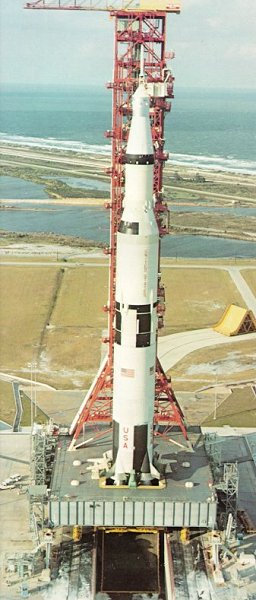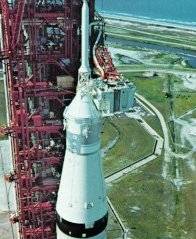
A LAUNCH EVERY OTHER MONTH
The centers - that's what we called intervals - between launches were two months. That is, Apollo 9 went in March, Apollo 10 in May, and Apollo 11 in July. But each vehicle took five months from the time its components arrived in the VAB until its launch. Thus the overlapping.Look at the situation in early March 1969. Apollo 9 on Pad A was ready for launch - delayed three days because the astronauts caught colds - and the team of 500 - engineers and technicians - was working twelve- or thirteen-hour days. Apollo 10 was ready to be rolled out of the 456-foot hangar doors of the VAB for two months of intensive checkout on Pad B. But the components of Apollo 11 had already arrived and were undergoing tests in the VAB and in the vacuum chambers of the Manned Spacecraft Operations Building. Apollo 11 would roll out at 12:30 p.m., May 20, one month and 26 days before it lifted off for the Moon.

| Getting set for the flames of an Apollo launch. The thrust chambers of the first stage's five engines extend into the 45-foot-square hole in the Mobile Launcher platform. Until liftoff, the flames will impinge downward onto a flame deflector that diverts the blast lengthwise in the flame trench. Here, a flame deflector coated with a black ceramic is in place below the opening, while a yellow (uncoated) spare deflector rests on its track in the background. It takes a tremendous flow of water (28,000 gollons per minute) to cool the flame deflector and trench. The pumps, which start 8 seconds before ignition, can deliver that flow for 30 seconds, and then a reduced flow for an indefinite period. Another 17,000 gpm of water curtains the Mobile Launcher tower from the rising flames. |

| The white room is the work platform, 400 feet in the air, through which a flight crew is loaded into the spacecraft. The crew arrives at the pad by van, ascends the launcher tower by elevator, and then crosses a swing arm to reach the white room. |
The pressure on these people was pretty severe. At a launch a person just sat there glued to his console, watching the needles for any sudden changes, knowing that he would be committing this big vehicle, with men aboard: a $400 million commitment. And it wasn't the money only, or the men. The entire world was watching for the success of the United States.
We had both to prepare the bird and to make sure our people could detect and understand any anomaly. I used to walk through the console panel area right up to about the last 45 minutes before liftoff. I'd be checking on alertness, especially among men who had been working long hours. Were they fatigued? Were they concentrating on the dials? Was there any unnecessary chit-chat going on? When we had long holds during the Countdown Demonstration Tests I had to judge how far we could go, whether we were pushing too hard, whether we had to call a delay and wait until the next day. The team had to be as well rehearsed as any ballet, or any football team. You do not get the commitment for launch without a lot of hard days and weeks and months of practice.
| Next |